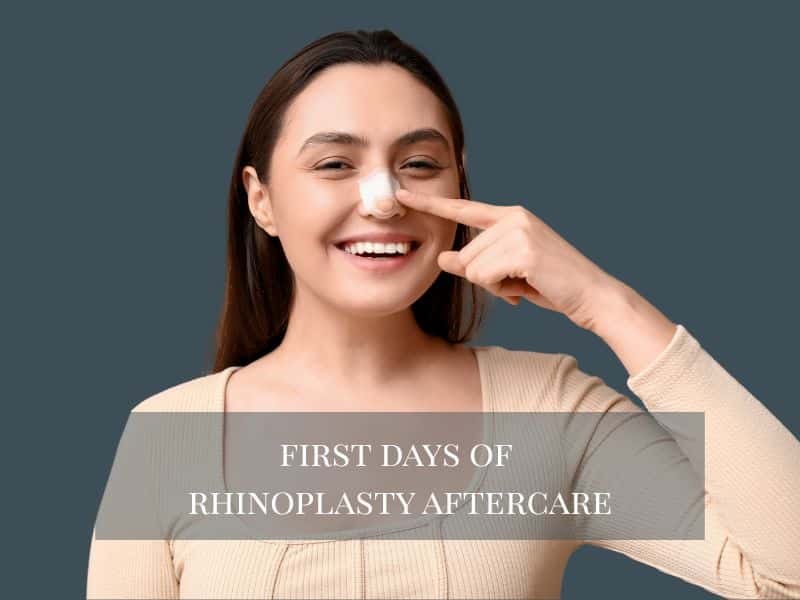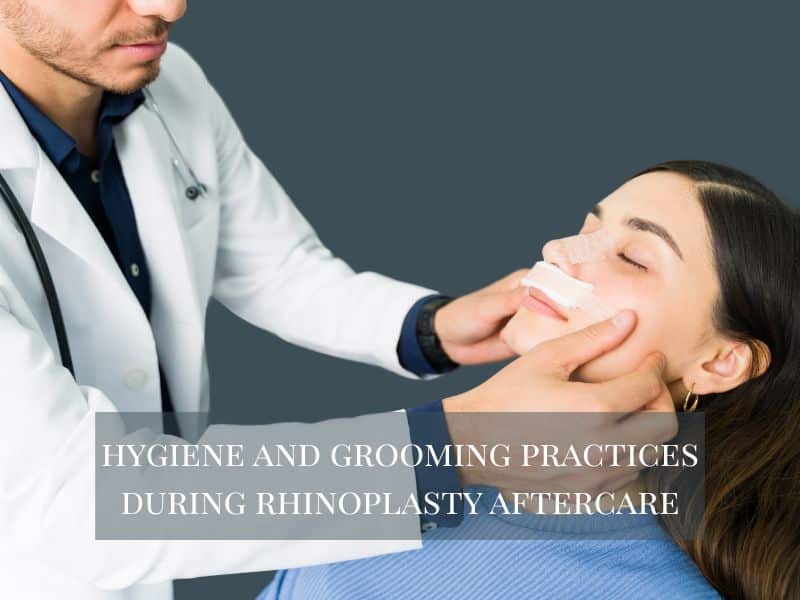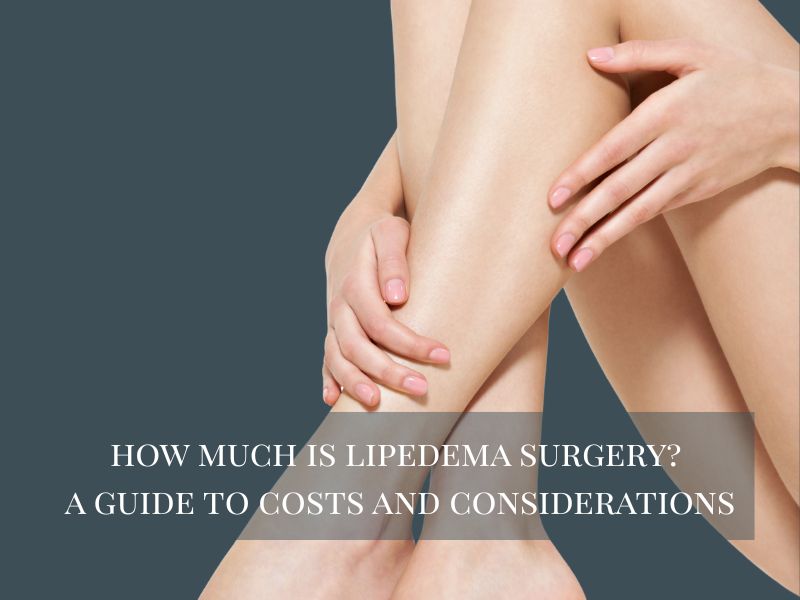Rhinoplasty aftercare is crucial for a smooth recovery and optimal results. That’s right—the best rhinoplasty results come not just from your surgeon’s expert work but from a healthy postoperative recovery period after the nasal surgery.
Taking care of your nose and following your surgeon’s instructions can help you reduce the risk of complications and ensure you heal properly and as quickly as possible.
This guide provides all of the essential tips you need to help you make your way through the recovery process after your rhinoplasty procedure.
First Days of Rhinoplasty Aftercare

You can expect some swelling, bruising, and mild discomfort in the first few days after rhinoplasty. Getting as much rest as possible and keeping your head elevated to reduce swelling is essential.
Avoid strenuous activities and bending over, as these can increase pressure on your nose. Stick to soft foods to avoid any strain. It’s normal to experience some nasal congestion, so breathe through your mouth if necessary.
Follow your surgeon’s instructions carefully, including any guidelines on cleaning your nose and changing your dressings. Taking it easy during this period is very important to ensure a smooth recovery.
Managing Dressings and Splints
Proper care of dressings and splints is essential after rhinoplasty surgery. Keep your dressings dry and intact to protect the surgical site. Avoid touching or adjusting them yourself; instead, let your surgeon handle any changes. If your splint feels loose or uncomfortable, contact your doctor for guidance.
Keep head elevated to minimize pressure on the nose. Avoid getting the area wet during showers, and use a damp cloth to clean your face instead.
Minimizing Swelling and Bruising
To reduce swelling and bruising after rhinoplasty, keep the head elevated at all times, even while sleeping. Apply cold compresses gently around the eyes and cheeks, but avoid direct pressure on the nose.
Stay hydrated and maintain a balanced diet rich in fruits and vegetables to support healing. Avoid alcohol and salty foods, as they can increase swelling. Stay away from any type of strenuous activities and heavy lifting, which can make bruising worse.
Hygiene and Grooming Practices During Rhinoplasty Aftercare

Maintaining proper hygiene after rhinoplasty is very important. Gently clean your face with a damp cloth, avoiding the nose area to keep dressings dry. Use a saline spray to keep your nasal passages moist, which can help prevent crusting. Avoid wearing glasses or sunglasses directly on your nose until your doctor approves.
When washing your hair, tilt your head back to avoid getting water on your face. Don’t use makeup around the nose and eyes until your nose is fully healed.
Following Medication and Pain Management Instructions
Sticking to your medication and pain management plan is essential after rhinoplasty procedure. Take all prescribed medications exactly as directed to manage discomfort and prevent infection.
Don’t skip doses, even if you feel fine, as this ensures consistent pain control and helps with healing. Avoid over-the-counter pain relievers unless your doctor has approved them, as some can increase the risk of bleeding. Stay in touch with your surgeon if you experience unexpected severe pain or side effects.
Rhinoplasty Surgery Frequently Asked Questions
What can I expect during the initial days of recovery from nose job?
Expect swelling, bruising, and mild discomfort. Rest is crucial, and keeping your head elevated will help reduce swelling. You might feel nasal congestion, so breathe through your mouth if needed. For best results, closely follow your doctor’s guidelines.
What isn’t a typical sign of healing?
Look for any odor, pus, or swelling and irritation beyond what was already present at the surgical site. Fever can also be a sign of severe infection. Contact your surgeon immediately if you have any of these symptoms.
When can I resume normal activities and exercise?
Light activities can typically resume after a couple of weeks, but avoid strenuous exercise for at least six weeks or until your doctor gives the go-ahead. Listen to your body and consult your surgeon before returning to your routine.
How does rhinoplasty address a deviated septum and what should I expect during recovery from this plastic surgery procedure?
Rhinoplasty can correct a deviated septum while also improving the nose’s shape, making it one of the most comprehensive plastic surgery procedures for both functional and aesthetic concerns.
The surgery is typically performed under local anesthesia or general anesthesia, and afterward, you’ll receive pain medication to manage discomfort during the healing process. It’s crucial to avoid putting pressure on your nose and to use a saline nasal spray as directed to keep the nasal septum area clean and moist.
Additionally, protecting your nose from sun exposure is essential during recovery, as UV rays can cause complications and affect healing, so always wear sunscreen and consider wearing a hat when outdoors.
How long does the healing process take?
Learning how rhinoplasty recovery works is crucial for setting realistic expectations about the healing timeline. Recovery time varies for each patient, with most people able to return to work within 1-2 weeks, though complete healing extends several months to a year for all swelling to resolve.
During this period, it’s important to avoid alcohol consumption as it can increase fluid retention and interfere with proper healing. In some cases, additional surgery may be needed for refinements once the initial healing is complete.
What specific instructions should I follow during the first week after rhinoplasty?
During the first week, your surgeon will provide specific instructions that are essential for proper wound care and optimal healing. You should apply cool compresses around your nose and eyes to reduce swelling and bruising, while being extra gentle when brushing your teeth to avoid disturbing your upper lip area.
It’s important to incorporate high fiber foods into your diet to prevent constipation that might strain your surgical site, and when you need to sneeze or cough, always keep your mouth open to avoid putting pressure on your nose. Protection from direct sunlight is critical, as UV exposure can cause permanent discoloration and interfere with healing.
What is non-surgical rhinoplasty?
Non-surgical rhinoplasty, also called liquid rhinoplasty or a liquid nose job, is a cosmetic procedure that uses dermal fillers like hyaluronic acid to temporarily change the shape of your nose without surgery.
The procedure can smooth bumps, lift the tip angle, or correct minor asymmetries, but it cannot make your nose smaller since it’s an augmentation procedure. Results typically last up to six months, and the treatment can be completed in one office visit, often taking 15 minutes or less.
What are the different types of rhinoplasty?
There are several types of rhinoplasty procedures available depending on your needs. Open rhinoplasty involves a small incision under the nose between the nostrils, providing better access for extensive reshaping. Closed rhinoplasty uses incisions inside the nostrils with no external scars, suitable for minor adjustments.
Other specialized types include tip plasty (focusing only on the nose tip), septorhinoplasty (combining functional and cosmetic improvements), revision rhinoplasty (correcting previous surgeries), and liquid rhinoplasty (using dermal fillers).
Does rhinoplasty leave scars?
Scarring from rhinoplasty depends on the technique used. Closed rhinoplasty places all incisions inside the nostrils, resulting in no visible scarring. Open rhinoplasty creates a small incision on the columella (the strip between nostrils), which may leave a tiny scar that is typically very difficult to see once healed.
Any scarring that does occur usually begins to fade around one week after surgery, with complete healing taking 3-6 months. Modern surgical techniques have made visible scarring very uncommon, and proper post-operative care can further minimize any scar formation.
How long does it take to recover from septoplasty?
Most patients can expect to feel significantly better within 7 to 14 days after septoplasty, though mild swelling and stuffiness may persist for a few weeks. Light activities can usually be resumed after several days, but it’s important to avoid strenuous exercise and nose blowing until your surgeon gives the go-ahead.
Full internal healing from septoplasty may take a few months, so following all post-operative care instructions is essential for the best outcome.
book your rhinoplasty procedure today
Proper rhinoplasty aftercare is essential for a smooth recovery and the best possible results. Follow your surgeon’s instructions on managing dressings, minimizing swelling, and maintaining proper hygiene.
Stick to your medication schedule and gradually return to normal activities once your doctor has cleared you to do so. These steps will help you heal properly and enjoy your new look.
If you have questions or need personalized guidance, consult with Dr. CV Chegireddy at Aesthera Plastic Surgery. His expertise is here to support you every step of the way. Contact us today to schedule your consultation.



